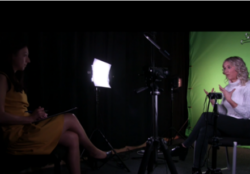Bringing Influencers into The Classroom with a Video Interview
Bringing time poor professionals into the classroom for a guest talk can be difficult. Furthermore, influencer’s time is expensive, so I needed to find a way to make it efficient and future-proof. I also wanted to keep it authentic to who they are and what they do.
What did you do and why did you do it?
I have always been interested in people and their stories, so it was not difficult for me to put my qualitative researcher skills to work to solve this problem. I decided to identify successful influencers (influencers are high quality content producers and opinion shapers on social media) and invite them for an in-depth interview with me. These interviews were filmed, edited and shown on Minerva to my 350+ PG students attending the Social Media Marketing modules (Flipped content). I asked LUBS (Leeds University Business School) Enhancement team to help because I wanted them to have high production value with clear audio as well as edited to show extracts from the influencers social media to underpin their story. The LUBS Enhancement Team have the right expertise to make this happen!
We had a very exciting hour of filming in the media suite at LUBS (see figure 1). I emailed the list of questions in advance to the influencers, Em Sheldon and RunnersKnees, because this is a media opportunity for them, and they like to be prepared. I asked them how they got into blogging, their best collaborations, how they integrate their activities across platforms, etc. The questions linked directly to the learning objectives about how influence works in social media, understanding the journey of successful influencers and how to collaborate effectively with them. You can see a clip from the video with Em Sheldon here. A good tip is to ask them to repeat the question when they answer, so that the question can be edited out reducing the length of the video. It also allowed for a modular format to the interview: I could decide which questions to keep and which ones to take out. This proved very important in the following years, if information was out of date (social media moves fast!) I could simply omit it and still have great content.

Figure 1: filming the interview
In class, I followed up with critical review questions for discussion, together with related academic literature. The result was a session that combined genuine influencer experiences with theory in an engaging way.
What was the impact of your practice and how have you evaluated it?
This practice added authenticity to the content that I explained in class. Having multiple voices explaining how influence works in social media helped gaining a pluralistic understanding of the topic.
I was also able to comment on the professionalism of the influencers, their media skills and hectic schedule (they were constantly on the phone arranging things). It was a pleasure to meet them in person, talking about their craft and experiences. Issues of trolling were, for example, discussed candidly.
Students were able to understand why dealing ethically with influencers is important, they could hear directly from them the best, and not so good, practice in the industry. For example, respecting the influencer’s voice and trusting their creativity, rather than imposing briefs that are too strict; paying proportionately to the effort required, alternating organic (non-sponsored) content with sponsored one.
Student feedback has been great regarding these sessions. One of my students even ended up working with one of the influencers a couple of years after graduation and reminisced of the class with her.
How could others benefit from this example?
The qualitative interview is a powerful tool to bring different voices into the classroom. Allowing the students to interpret and comment on the influencers’ interviews delivered high engagement. This was shown in the video views but also in the comments of the students. Some shared their own ambitions to be influencers, some commented on the quality of the influencers’ content and admired the work put into it. Empathising and appreciating their story went a long way in explaining the importance of respectful working relationships and the humanity of online influencers.
Furthermore, the edited video format is consistent with the University of Leeds brand, an efficient way to deliver content and reuse it! Finally, please do not be afraid to ask for help from the pros to make your vision happen!
Author
Caterina Presi, C.Presi@lubs.leeds.ac.uk, Marketing Department, Leeds University Business School.
Do you have an example of your practice to share?
If you are interested in submitting an article to the TIPS Blog find out how to submit here, or contact the TIPS Editors at academicdev@leeds.ac.uk
